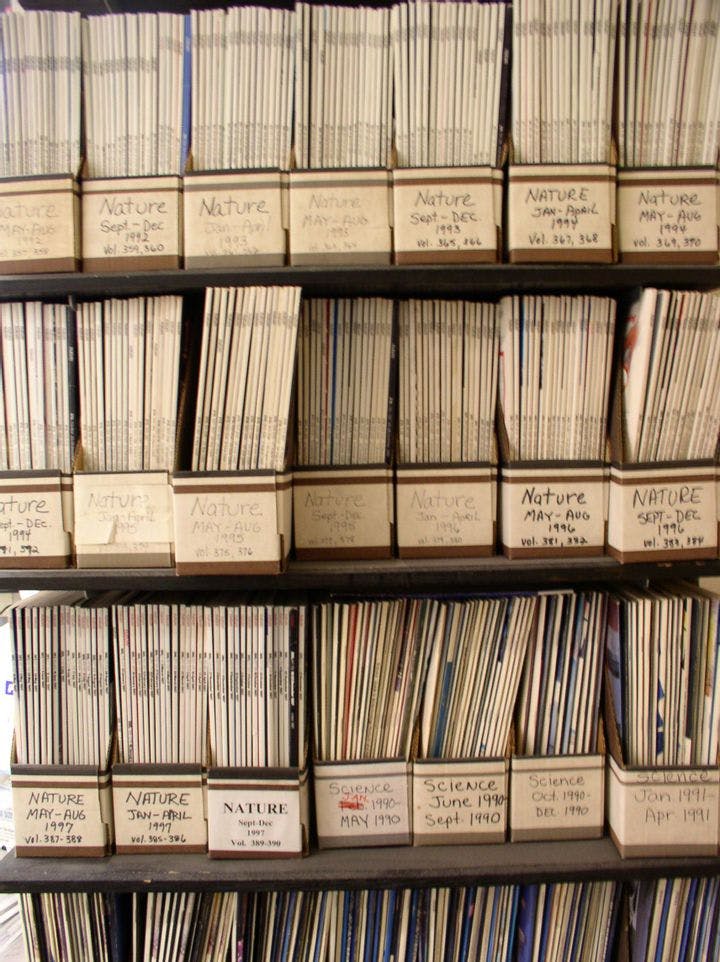Winter 2011
Journals Galore
– The Wilson Quarterly
"Nearly the whole lives of zoologists will come to be spent in libraries, until the thing gets so intolerable that someone will suggest that we burn all the books and start afresh from nature."
If a scientist publishes new findings in a journal and no one reads the article, did that scientist still make a discovery?
That question is not very relevant to researchers today because powerful online databases ensure that a publication won’t be lost to history. But for scientists in the 19th century, a sudden profusion of specialized scientific periodicals combined with the absence of a tracking system for publications made the threat of obscurity very real, writes Harvard historian Alex Csiszar. One English physicist remarked that “the rediscovery in the library may be a more difficult and uncertain process than the first discovery in the laboratory.”
When scientific journals emerged in the 17th century “they would have been among the last places to look to find authoritative knowledge claims,” Csiszar says. Books and monographs, and even informal correspondence among colleagues, not periodicals, were the agreed-upon space in which to document scientific advances. Like newspapers and gazettes of that era, the early scientific journals were not seen as reliable. Many functioned more as specialty news sources, summarizing findings from books.
The development of organizational systems such as comprehensive indexes and bibliographies lagged behind the proliferation of journals. For scientists, this meant that simply knowing what was known was often impossible. Zoologists, for example, found it increasingly challenging to determine whether a species identified as new really was unknown to the scientific establishment. One complained, “Nearly the whole lives of zoologists will come to be spent in libraries, until the thing gets so intolerable that someone suggests that we burn all the books and start afresh from nature.”
Moreover, in the period before scientific journals established their authority, credit for discoveries was often contested. In 1846, when Neptune was first observed by telescope, a French publication credited astronomer Urbain Le Verrier with having earlier predicted the planet’s existence. British astronomers protested that John Couch Adams had done so first, in a conjecture that was unpublished but “a subject of common conversation” among his friends. One Frenchman responded that the only “rational and just way to write the history of science is to rely exclusively on publications having a precise date.”
Over time, that position prevailed. By the beginning of the 20th century, authoritative scientific journals were the place to establish credentials and make findings public. In 1902, Britain’s Royal Society initiated the publication of the International Catalogue of Scientific Literature, an annual index running 17 volumes in length and covering all major areas of scientific research.
The rise of journals posed a problem that was bigger than how to organize publications; it was a question of how to organize the entire field of science. Before journals, a common metaphor for nature was a book. Nature was a self-contained, intelligible document that scientists could “read.” But by 1900, the metaphor had changed. Mathematician and physicist Henri Poincaré referred to nature, as Csiszar puts it, “as a vast expanse of print matter, a body the scientist did not so much read through, as search, select from, and catalog.” The medium, it seems, represented the message.
* * *
The Source: "Seriality and the Search for Order: Scientific Print and Its Problems During the Late 19th Century" by Alex Csiszar, in History of Science, September-December 2010.
Photo courtesy of Flickr/Robert Cudmore
